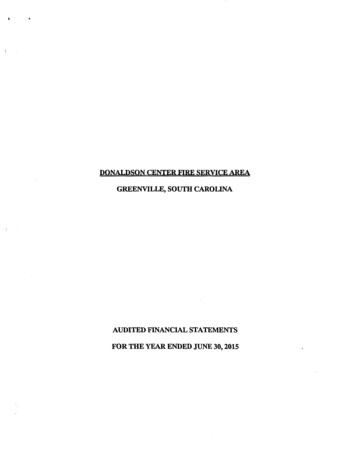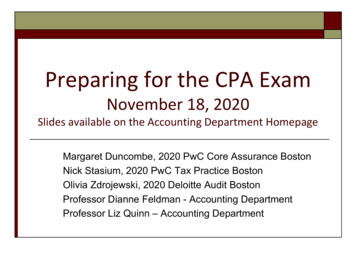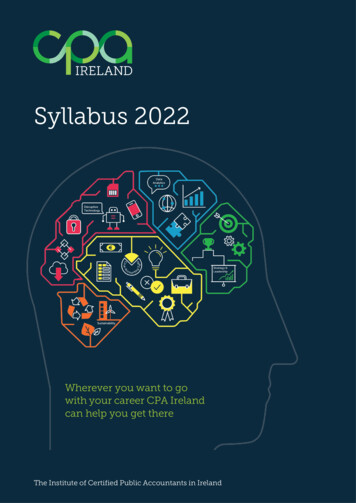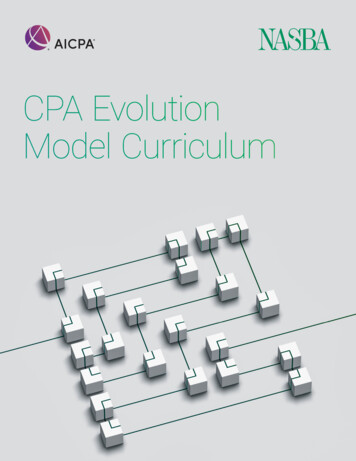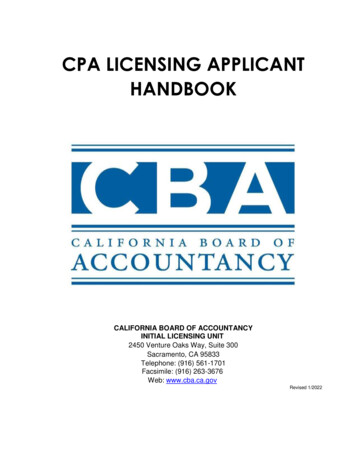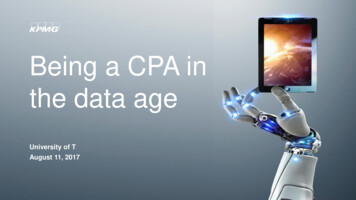
Transcription
Being a CPA inthe data ageUniversity of TAugust 11, 2017
AgendaDigitization of AccountingDigital Transformation ExamplesPersonnel, Skillsets, and CapabilitiesImplementing Digital TransformationQuestions 2017 KPMG LLP, a Delaware limited liability partnership and the U.S. member firm of the KPMG network of independent member firms affiliated with KPMG International Cooperative (“KPMG International”), a Swiss entity. Allrights reserved. NDPPS 6770722
Digitizationof accounting
Explosion of Data 2017 KPMG LLP, a Delaware limited liability partnership and the U.S. member firm of the KPMG network of independent member firms affiliated with KPMG InternationalCooperative (“KPMG International”), a Swiss entity. All rights reserved. NDPPS 6770724
Risk of U.S. jobs being computerized in next twodecadesJob50/50YesNo“The Future of Employment: HowSusceptible are Jobs toComputerization”C Frey and M. Osborne (2013) 2017 KPMG LLP, a Delaware limited liability partnership and the U.S. member firm of the KPMG network of independent member firms affiliated with KPMG InternationalCooperative (“KPMG International”), a Swiss entity. All rights reserved. NDPPS 6770725
CEOs say applying financial data to achieveprofitable growth is the greatest strategic valueof a CFOYesNo85%Forbes Insights and KPMG InternationalCEO November 2015 Survey 2017 KPMG LLP, a Delaware limited liability partnership and the U.S. member firm of the KPMG network of independent member firms affiliated with KPMG InternationalCooperative (“KPMG International”), a Swiss entity. All rights reserved. NDPPS 6770726
CFO’s plan to improve the analytical skill set oftheir existing finance team in the coming yearYesNo60%CFO Annual IT Survey – 2017“Data and Analytics: TheCFO’s Evolving Role 2017 KPMG LLP, a Delaware limited liability partnership and the U.S. member firm of the KPMG network of independent member firms affiliated with KPMG InternationalCooperative (“KPMG International”), a Swiss entity. All rights reserved. NDPPS 6770727
Digitaltransformationexamples
Examples of available technologiesExtractionData storageAdvancedTransformation & databaseExample technology elements: big dataanalyticsand zationsData crosoftSQL Server—R Studio—IBM Watson—Pentaho—Alteryx—QlikView—Postgre asticSearch—IP onAnywhere—Cloudera—Python 2017 KPMG LLP, a Delaware limited liability partnership and the U.S. member firm of the KPMG network of independent member firms affiliated with KPMG InternationalCooperative (“KPMG International”), a Swiss entity. All rights reserved. NDPPS 677072—Tableau9
Example areas for digital transformationInvestor relationsLeverage analytics to help explain toanalysts the underlying drivers ofpast business performance, e.g.,impact of weather on sales.Customer knowledgeIdentify consumer tastes and trendsby monitoring data and social mediaactivity and build into your productdevelopment and revenue plans.Financial planningDevelop predictive models usinginternal and external data to createmore accurate forecasts, andplanning models.ComplianceUse data to better monitor forchanges that will impact thecompany’s compliance obligationsand related business processes. 2017 KPMG LLP, a Delaware limited liability partnership and the U.S. member firm of the KPMG network of independent member firms affiliated with KPMG InternationalCooperative (“KPMG International”), a Swiss entity. All rights reserved. NDPPS 67707210
Journal entry analysisGreat entry point into using data & analysis— Most financial personnel are familiar with the GL system— Extracting data from the GL system is a common occurrence— Entire population subject to analysis— “Jumping” from GL entries to actionable insights via D&A feels like a small stepActionable insights include— Cross-entity comparisons— Volume of automation vs. manual intervention— Compliance with policies/controls— Assessment of non-typical journal entries— Global reach 2017 KPMG LLP, a Delaware limited liability partnership and the U.S. member firm of the KPMG network of independent member firms affiliated with KPMG InternationalCooperative (“KPMG International”), a Swiss entity. All rights reserved. NDPPS 67707211
Journal entries analysisGenerate highly customizable analyses for identification of inappropriate journal entries.— Journal entries recorded on weekends, holidays, or unusual times outside of business hours that may indicate fraudulentactivityBenefits— All journal entries recorded by a preparer or approver, can be analyzedFilter weekendtothe companyValuesSaturdayAutomated ormanual entrySundayDocument number –distinct countUser nameAutomatedManualAmount in documentcurrency – 649515,608Document number –distinct countAmount in documentcurrency – sum5,7441,042,15723,0701740Manual and Automated Journal Entry Postings on WeekendsE8DEE2FC-1AFEC241F8E-315Manual TotalGrand TotalAccountnumberAccount categoryA6B98EB7-DTrade receivables third party99AC9424-6Dr ,8817,565,2956,0631,719,036Cr amountLocalcurrencyUser namePosting dateEntry dateAuto ormanual?1,097,300- USDEC241F8E-3152013-09-302013-10-05 ManualNon current assets-1,097,300 USDEC241F8E-3152013-09-302013-10-05 Manual99AC9424-6Non current assets1,097,300- USDEC241F8E-3152013-09-302013-10-05 ManualA1A21AX7-BCash-1,097,300 USDEC241F8E-3152013-09-302013-10-05 Manual—Assess manual vs.automated entries forautomation andstandardization—Leverage investment inERP/integrated accountingsystems—Support controleffectiveness—Identify problems whilesmall—Full population/real time 2017 KPMG LLP, a Delaware limited liability partnership and the U.S. member firm of the KPMG network of independent member firms affiliated with KPMG InternationalCooperative (“KPMG International”), a Swiss entity. All rights reserved. NDPPS 67707212
Revenue 3 way matchEvaluates 100% of sales activities for each period bymatching transactions in revenue to relevant informationper the customer purchase order, shipping document, andsales invoiceA three-way match for goods based on key information:quantity per the customer purchase order is agreed to theshipping document and sales invoice and pricing per thecustomer purchase order is agreed to the sales invoice 2017 KPMG LLP, a Delaware limited liability partnership and the U.S. member firm of the KPMG network of independent member firms affiliated with KPMG InternationalCooperative (“KPMG International”), a Swiss entity. All rights reserved. NDPPS 67707213
Revenue 3 way match – Results124 transactions for atotal of 17,613,913were identified withprice differences 922,422 total“extended” differenceor 0.3% of totalamount tested94.5% oftransactionsanalyzed containedno price differencesPrice difference analysisRevenues subjectto 3 way match# oftransactions% (amount)% %0PO invoice price14,438,076734.5%4.2%823,682PO invoice 100.0%922,422Price risk categoryNo differenceTotal 2017 KPMG LLP, a Delaware limited liability partnership and the U.S. member firm of the KPMG network of independent member firms affiliated with KPMG InternationalCooperative (“KPMG International”), a Swiss entity. All rights reserved. NDPPS 67707214
Revenue 3 way match – Results72% of transactionsanalyzed containedno quantitydifferences489 transactions for atotal of 89,942,047were identified withquantity differences 19,543,001 total“extended” differenceor 6.1% of totalamount testedQuantity difference analysisRevenues subjectto 3 way match# oftransactions% (amount)% 3%0PO Invoice quantity000%0%0PO Invoice 541764100.0%100.0%19,543,001Quantity risk categoryNo differenceTotal 2017 KPMG LLP, a Delaware limited liability partnership and the U.S. member firm of the KPMG network of independent member firms affiliated with KPMG InternationalCooperative (“KPMG International”), a Swiss entity. All rights reserved. NDPPS 67707215
Conflicting authorization in purchasingtransactionsPotential risk where 7 users posted 10million in transactions with conflictingauthorizations: goods/service receiptentry, A/P invoice entry, and paymentapprovalAfter investigating the underlyingtransactions and discussing with theclient, we may conclude there is little orno risk here.The business may wish to streamlineauthorizations and eliminate a potentialcontrol deficiency related to the numberof individuals with conflicting duties. 2017 KPMG LLP, a Delaware limited liability partnership and the U.S. member firm of the KPMG network of independent member firms affiliated with KPMG International Cooperative (“KPMG International”), a Swiss entity. Allrights reserved. NDPPS 67707216
Managing claimsThe challenge:Carrier A approach— Used data toanalyze specificclaims metrics toidentify patternsaround policiesunderwritten byindependentagents.— Used the metrics torate the agents andcreated a plan tofocus on monitoringand mentoring theagents that areperforming poorlyCarrier B approachTwo insurance carriers identified that a significant number ofclaims result from the policies underwritten by theirindependent agents. How do they identify the culprits andreduce the amount of claims?Carrier A outcome— Terminated theirindependent agentsthat underwrote thepolicies whichresulted insignificant claims— Number of claimswas reducedCarrier B outcome— Revenue decreasedslightly due tohigher scrutiny ofspecific metrics— Number of claimswas reduced— Most independentagents improvedwhile others leftvoluntarily 2017 KPMG LLP, a Delaware limited liability partnership and the U.S. member firm of the KPMG network of independent member firms affiliated with KPMG InternationalCooperative (“KPMG International”), a Swiss entity. All rights reserved. NDPPS 677072— Revenue decreasedsignificantly— Company liquidated17
Impact of weather patternsModeling scope of the consumer decision journeyThe— Model the impact of discrete weather behavior atchallengeindividual locations on weekly store sales performance.KPMG— Create a model that statistically linked weatherresponseobservations geo-mapped to individual store locationswith differences between forecast and actual storesales.Scope of modeled weather impactConsumerProfileShoppingTriggersAbilityto PayMarketingAvailability/Schedule“Need”1W eather aside,will I go to thestore?Given theweather, do I goto the store?YesYesNoBrandPreferenceDo I buysomething instore? NoYesNoBy definition, the “No” paths are not modeled because they cannotbe observed these in the sales and traffic dataOther Other YesDo I buysomething online?Explaining the impact in retail comp termsNo* In theory , weather its elf may be a trigger for a c ons umer to initiate a s hopping trip in order to buy a s pec ific item. How ev er, item s elec tion was bey ondthe s c ope of this modeling ex erc is e, whic h foc us ed on the aggregate impac t of weather on ov erall s tore performanc e. 2014 KPMG LLP, a Delaware limited liability partnership and the U.S. member firm of the KPMG network of independentfirms affiliated with KPMG International Cooperative (“KPMG International”), a Swiss entity. All rights reserved.2memberWeekly Dollar Sales10— Calculate the impact of weather on sales for a givenweek and adjusted rates for same-store weekly salescomps.Benefits — Ability to estimate how weather contributes toto retailerdeviations from its sales forecasts each pactWeatherImpactActual 5% 20%ReportedLY CompWeatherAdjustedLY CompLY4 2014 KPMG LLP, a Delaware limited liability partnership and the U.S. member firm of the KPMG network of independent memberfirms affiliated with KPMG International Cooperative (“KPMG International”), a Swiss entity. All rights reserved.— Identification of where non-weather-related factorsinfluenced sales and operational performance.— Better understanding of customer buying pattern. 2017 KPMG LLP, a Delaware limited liability partnership and the U.S. member firm of the KPMG network of independent member firms affiliated with KPMG InternationalCooperative (“KPMG International”), a Swiss entity. All rights reserved. NDPPS 67707218
Predicting student withdrawalsThe— A leading university wanted to reduce students leavingchallengebefore graduating by approaching at-risk students withtargeted remedial actions to prevent their withdrawal.KPMG— Developed a survival analysis model that combinedresponseadvanced analytics, various data sources, along withmachine learning, to identify characteristics of studentslikely to leave the university prematurely.— Model examined over 1,500 initial data signals, pullsdata from relevant sources, and provides a hazard scorefor each student.— Model enables the university to intervene on a timelybasis with customized interventions to improve studentretention.Benefits — Improved student retention increased tuition revenuesto— Enhanced brand through higher graduation ratesuniversity— Changes to curriculum, faculty, classroom and housingneeds 2017 KPMG LLP, a Delaware limited liability partnership and the U.S. member firm of the KPMG network of independent member firms affiliated with KPMG InternationalCooperative (“KPMG International”), a Swiss entity. All rights reserved. NDPPS 67707219
Automated intelligenceThechallenge— Company sells 5B of assets but needs to review 2 milliondocuments to ensure that sensitive documents are held back whiledocuments of the sold assets go to the acquirer.Ingestion— Challenges in the form of complex file structure and documenttypes, plus highly specialized technical and proprietary content(a.k.a. unstructured data)KPMGresponse— Leveraging its Athena Document Cognitive Automation Frameworkfor:- Acquisition, scanning, and ingestion of 2 million documents- Three-Tiered strategy to classify documents as going to Sellervs. Acquirer- Document Risk Scoring for review by Seller subject matterexpertsHigh performanceenvironment- Reporting, Visualization, and Interactive RefinementBenefitsto seller— Cost Reduction - 28 vs. .49 per document— Efficiency - 8 FTE/12 months vs. 4 FTE/4 months— Coverage - sample vs. 100%— Clear audit trail of documents to be disclosed/retained, and reasonsfor the determinations. 2017 KPMG LLP, a Delaware limited liability partnership and the U.S. member firm of the KPMG network of independent member firms affiliated with KPMG InternationalCooperative (“KPMG International”), a Swiss entity. All rights reserved. NDPPS 67707220
What is cognitive technology?— A major element of artificial intelligence and self-learning systems that uses data mining, patternrecognition and natural language processing to simulate human thought processes— Powered by machine learning algorithms that continually acquire knowledge and, as it learns,becomes capable of anticipating new problems and modeling approaches in responseThe analytical capabilities of cognitive technology are well-suited to the expanding data volumes andautomated analytical processes prevalent in today’s audit environment. 2017 KPMG LLP, a Delaware limited liability partnership and the U.S. member firm of the KPMG network of independent member firms affiliated with KPMG International Cooperative (“KPMG International”), a Swiss entity. Allrights reserved. NDPPS 67707221
Benefits of Cognitive Technology1Extracting key attributes fromunstructured data2Training the cognitive system to performjudgmental activities3Engaging machine learning to enhanceitems 1 and 2 above 2017 KPMG LLP, a Delaware limited liability partnership and the U.S. member firm of the KPMG network of independent member firms affiliated with KPMG International Cooperative (“KPMG International”), a Swiss entity. Allrights reserved. NDPPS 67707222
CMLA prototype summary 2017 KPMG LLP, a Delaware limited liability partnership and the U.S. member firm of the KPMG network of independent member firms affiliated with KPMG International Cooperative (“KPMG International”), a Swiss entity. Allrights reserved. NDPPS 67707223
Robotics changing the way business is done 152.7billionThe global market for robots and artificial intelligence is expected to reach 152.7 billion by 2020. The adoption of these technologies could improveproductivity by 30 percent. Bank of America Merrill Lynch Recent research from the London School of Economicssuggests a return on investment in robotic technologiesof between 600% and 800% for specific tasks600% and800% ROI 1.7billionMcKinsey research suggests that smart robots will replace more than100 million knowledge workers – or one-third of the world’s jobs – by 2025 2017 KPMG LLP, a Delaware limited liability partnership and the U.S. member firm of the KPMG network of independent member firms affiliated with KPMG InternationalCooperative (“KPMG International”), a Swiss entity. All rights reserved. NDPPS 67707224
Personnel, skillsets andcapabilities
Accountant for the data ageIs prepared for how the profession has evolvedand will evolve in the futureIs empowered withdata and analytics skillsetsMaintains a firm foundation in accounting, auditing,tax, financial reporting and business acumenIs innovativeEmbraces changeApplies advancedtechnologies with ease 2017 KPMG LLP, a Delaware limited liability partnership and the U.S. member firm of the KPMG network of independent member firms affiliated with KPMG InternationalCooperative (“KPMG International”), a Swiss entity. All rights reserved. NDPPS 67707226
Knowledge areas for data age accountantsCommon challengesand risksCollection, cleaningand analysis of dataDatabase designCommon ERPcapabilitiesTechnology and optionsfor visualizationsDecision makingin the Data AgeUse of predictive,prescriptive andregression analysisCommitment of time andpatienceModeling patternsof data, outliersand anomalies 2017 KPMG LLP, a Delaware limited liability partnership and the U.S. member firm of the KPMG network of independent member firms affiliated with KPMG InternationalCooperative (“KPMG International”), a Swiss entity. All rights reserved. NDPPS 67707227
KPMG Master ofAccounting with Dataand Analytics ProgramThe first-of-its-kind Programis being developed at:̶The Ohio State University Max M.Fisher College of Business̶Villanova School of Business̶Additional partner universities willbe addedConnecting with academia tobuild accountants for thedata age 2017 KPMG LLP, a Delaware limited liability partnership and the U.S. member firm of the KPMG network of independent member firms affiliated with KPMG International 2017a KPMGLLP, aAllDelawarelimited liabilitypartnershipCooperative (“KPMG International”),Swiss entity.rights reserved.NDPPS677072 and the U.S. member firm of theKPMG network of independent member firms affiliated with KPMG InternationalCooperative (“KPMG International”), a Swiss entity. All rights reserved.28
KPMG master of accounting withdata and analytics programDemonstrates theimportance placed by theprofession on a qualityeducationEncourages morestudents to obtain aCloses the gapbetween academicpreparation andaccounting careerreadinessgraduateeducation beforeentering the accountingprofessionInfluences thebroader academic andstudent community topursue an advancedcurriculum that includesAccelerates “time toimpact” for newaccounting professionalsSets the tone foracademic innovation inaccountingdata and analytics 2017 KPMG LLP, a Delaware limited liability partnership and the U.S. member firm of the KPMG network of independent member firms affiliated with KPMG InternationalCooperative (“KPMG International”), a Swiss entity. All rights reserved. NDPPS 67707229
Implementingdigitaltransformation
Considerations to implement digital transformation— Connect strategic decision-makers with operational owners and D&Apractitioners by partnering with business units and functions to changemindsets and identify and drive most valuable opportunities in analytics— Utilize your unique position to own the strategy for maximum data sharing inorder to drive data democratization— Partner with the CIO to invest in nimble technology layers that enableanalytics on top of the ERP backboneDigitalization is not easyMissing Skills – Data Access – Data Quality – Disparate Systems – Data to Insights – Silver Bullet MentalityTime & patience 2017 KPMG LLP, a Delaware limited liability partnership and the U.S. member firm of the KPMG network of independent member firms affiliated with KPMG InternationalCooperative (“KPMG International”), a Swiss entity. All rights reserved. NDPPS 67707231
Price difference analysis Price risk category Revenues subject to 3 way match # of transactions % (amount) % (number) Extended difference 124 transactions for a total of 17,613,913 were identified with price differences 94.5% of transactions analyzed contained no price differences 922,422 total "extended" difference or 0.3% of total .




